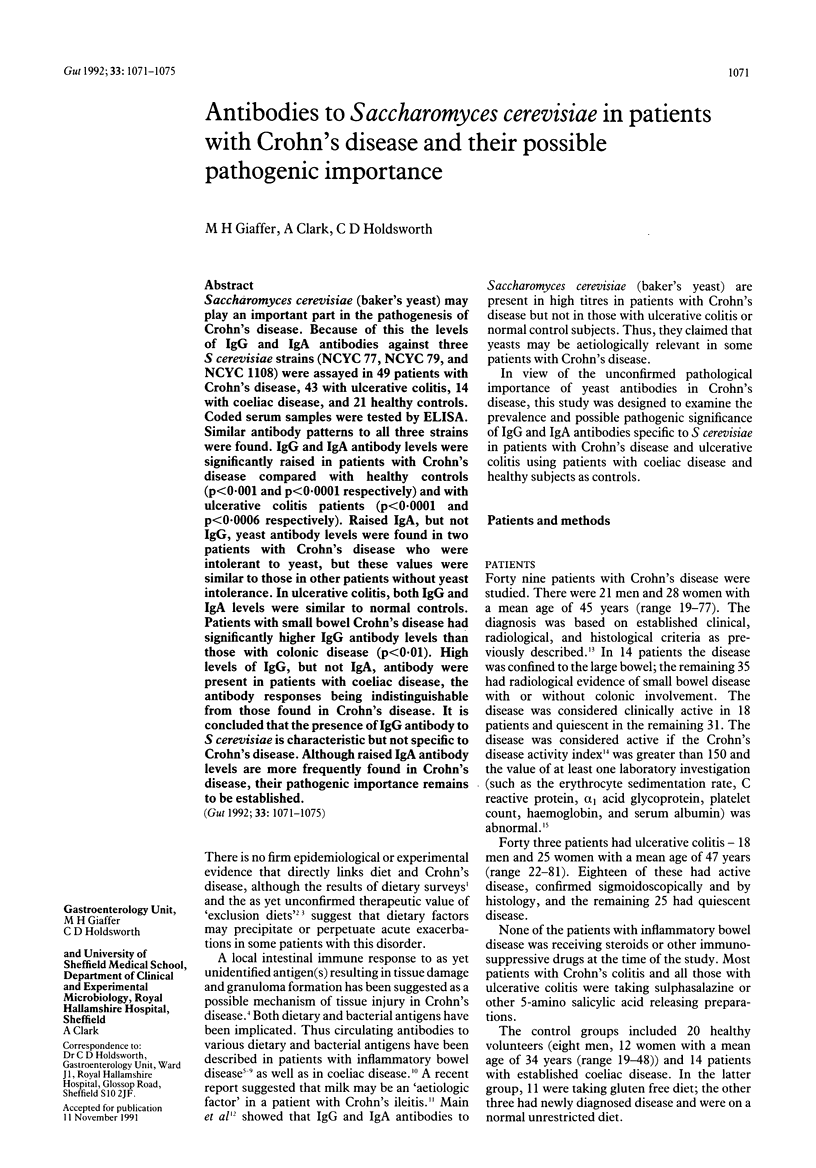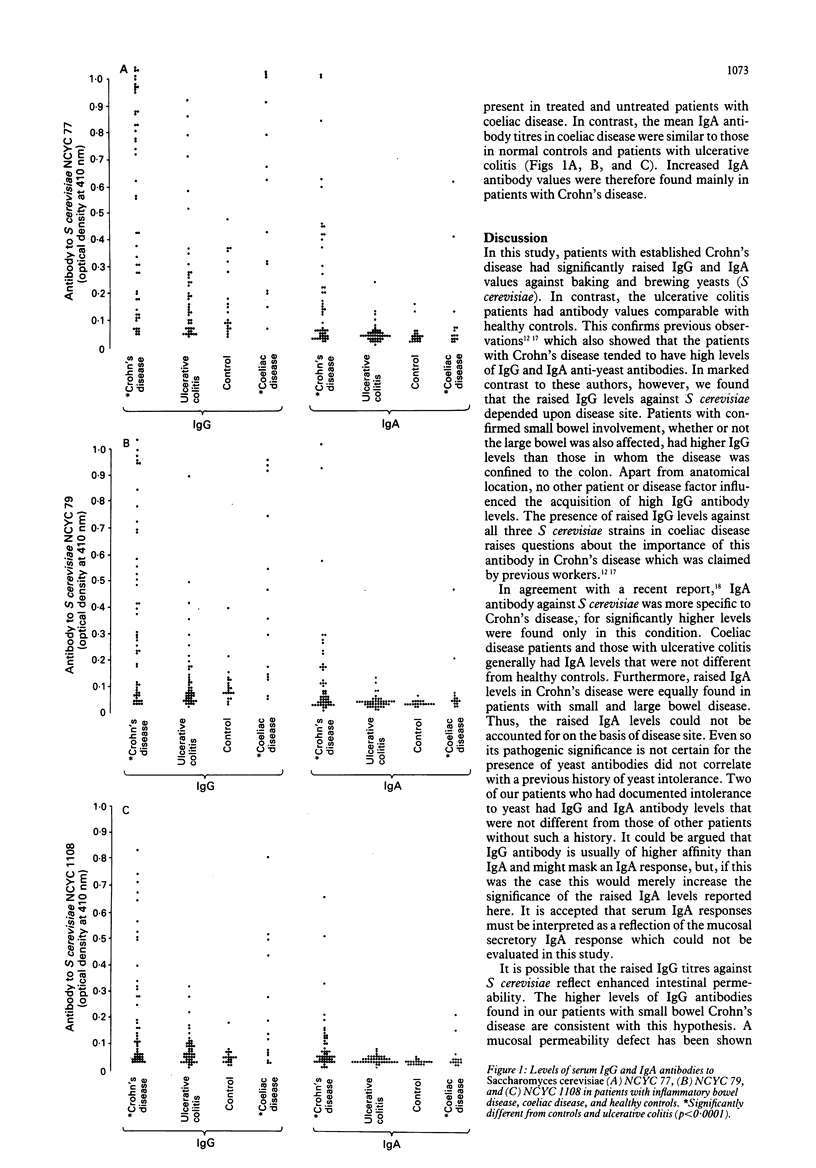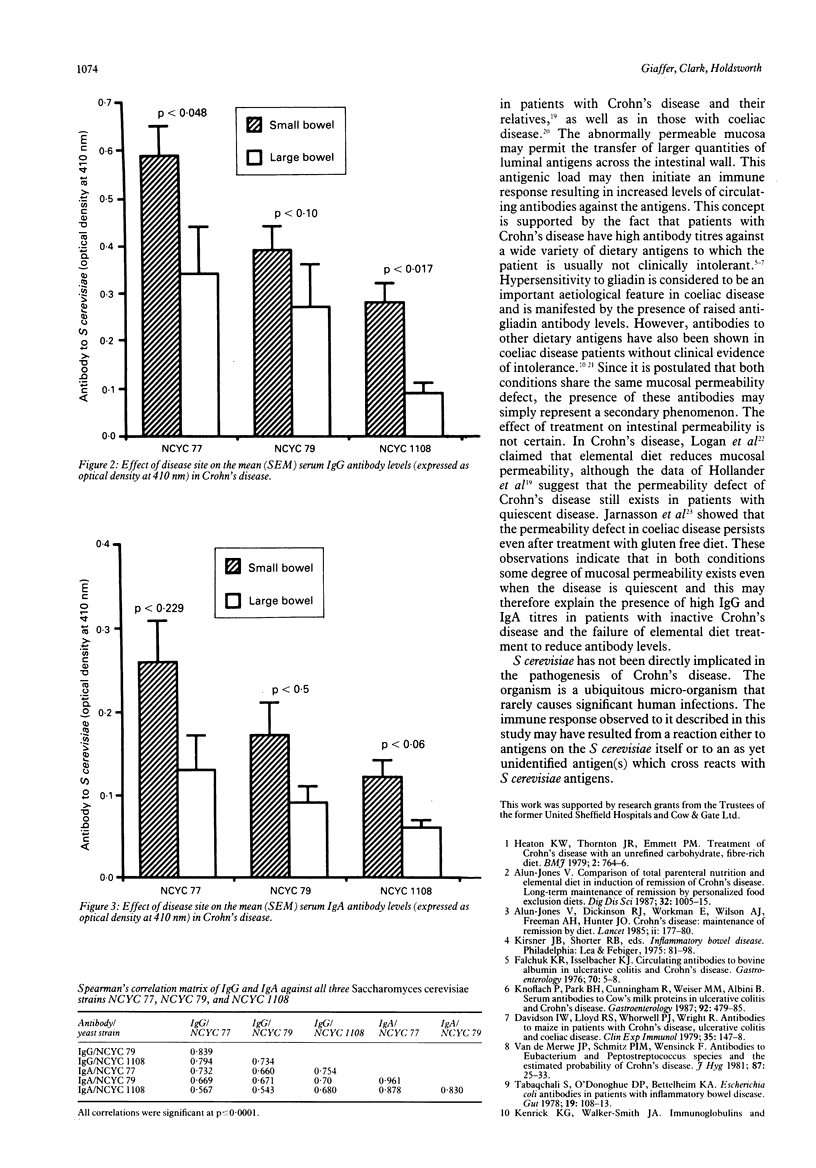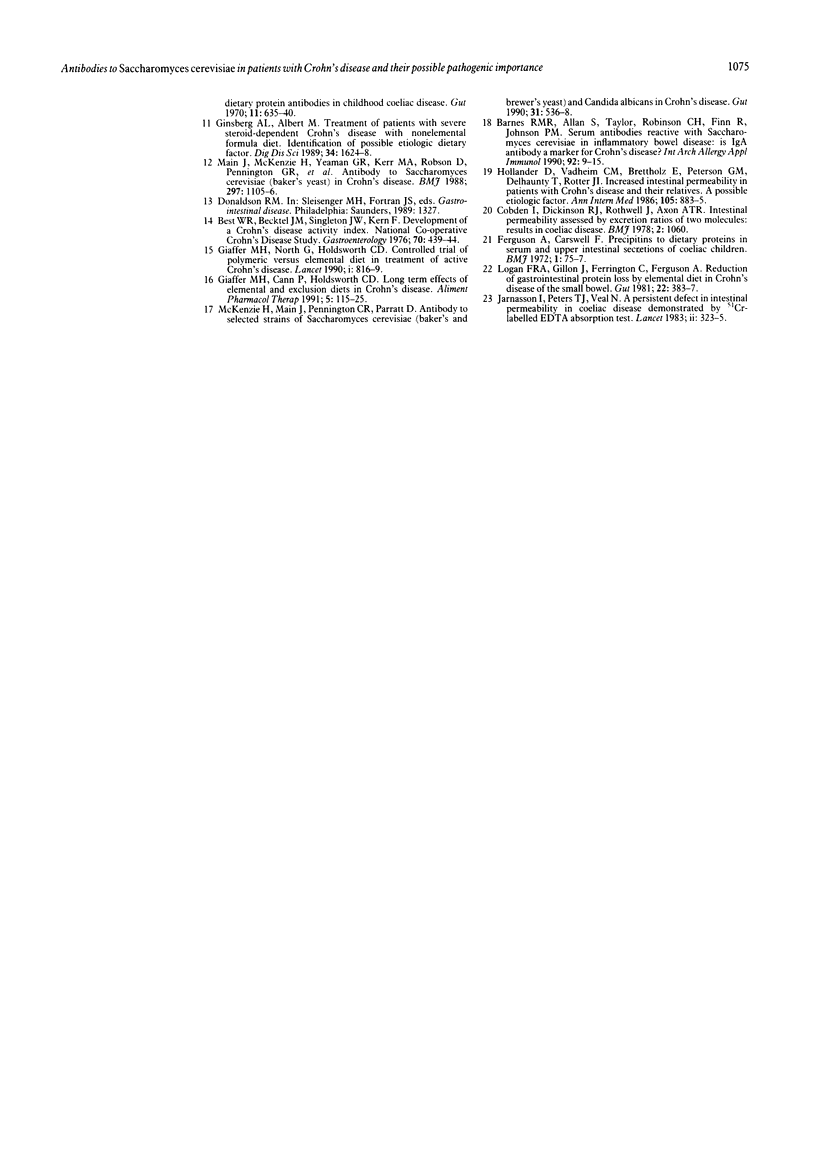Abstract
Saccharomyces cerevisiae (baker's yeast) may play an important part in the pathogenesis of Crohn's disease. Because of this the levels of IgG and IgA antibodies against three S cerevisiae strains (NCYC 77, NCYC 79, and NCYC 1108) were assayed in 49 patients with Crohn's disease, 43 with ulcerative colitis, 14 with coeliac disease, and 21 healthy controls. Coded serum samples were tested by ELISA. Similar antibody patterns to all three strains were found. IgG and IgA antibody levels were significantly raised in patients with Crohn's disease compared with healthy controls (p < 0.001 and p < 0.0001 respectively) and with ulcerative colitis patients (p < 0.0001 and p < 0.0006 respectively). Raised IgA, but not IgG, yeast antibody levels were found in two patients with Crohn's disease who were intolerant to yeast, but these values were similar to those in other patients without yeast intolerance. In ulcerative colitis, both IgG and IgA levels were similar to normal controls. Patients with small bowel Crohn's disease had significantly higher IgG antibody levels than those with colonic disease (p < 0.01). High levels of IgG, but not IgA, antibody were present in patients with coeliac disease, the antibody responses being indistinguishable from those found in Crohn's disease. It is concluded that the presence of IgG antibody to S cerevisiae is characteristic but not specific to Crohn's disease. Although raised IgA antibody levels are more frequently found in Crohn's disease, their pathogenic importance remains to be established.
Full text
PDF




Selected References
These references are in PubMed. This may not be the complete list of references from this article.
- Barnes R. M., Allan S., Taylor-Robinson C. H., Finn R., Johnson P. M. Serum antibodies reactive with Saccharomyces cerevisiae in inflammatory bowel disease: is IgA antibody a marker for Crohn's disease? Int Arch Allergy Appl Immunol. 1990;92(1):9–15. doi: 10.1159/000235217. [DOI] [PubMed] [Google Scholar]
- Best W. R., Becktel J. M., Singleton J. W., Kern F., Jr Development of a Crohn's disease activity index. National Cooperative Crohn's Disease Study. Gastroenterology. 1976 Mar;70(3):439–444. [PubMed] [Google Scholar]
- Bjarnason I., Peters T. J., Veall N. A persistent defect in intestinal permeability in coeliac disease demonstrated by a 51Cr-labelled EDTA absorption test. Lancet. 1983 Feb 12;1(8320):323–325. doi: 10.1016/s0140-6736(83)91628-8. [DOI] [PubMed] [Google Scholar]
- Cobden I., Dickinson R. J., Rothwell J., Axon A. T. Intestinal permeability assessed by excretion ratios of two molecules: results in coeliac disease. Br Med J. 1978 Oct 14;2(6144):1060–1060. doi: 10.1136/bmj.2.6144.1060. [DOI] [PMC free article] [PubMed] [Google Scholar]
- Davidson I. W., Lloyd R. S., Whorwell P. J., Wright R. Antibodies to maize in patients with Crohn's disease, ulcerative colitis and coeliac disease. Clin Exp Immunol. 1979 Jan;35(1):147–148. [PMC free article] [PubMed] [Google Scholar]
- Falchuk K. R., Isselbacher K. J. Circulating antibodies to bovine albumin in ulcerative colitis and Crohn's disease. Characterization of the antibody response. Gastroenterology. 1976 Jan;70(1):5–8. [PubMed] [Google Scholar]
- Giaffer M. H., Cann P., Holdsworth C. D. Long-term effects of elemental and exclusion diets for Crohn's disease. Aliment Pharmacol Ther. 1991 Apr;5(2):115–125. doi: 10.1111/j.1365-2036.1991.tb00012.x. [DOI] [PubMed] [Google Scholar]
- Giaffer M. H., North G., Holdsworth C. D. Controlled trial of polymeric versus elemental diet in treatment of active Crohn's disease. Lancet. 1990 Apr 7;335(8693):816–819. doi: 10.1016/0140-6736(90)90936-y. [DOI] [PubMed] [Google Scholar]
- Ginsberg A. L., Albert M. B. Treatment of patient with severe steroid-dependent Crohn's disease with nonelemental formula diet. Identification of possible etiologic dietary factor. Dig Dis Sci. 1989 Oct;34(10):1624–1628. doi: 10.1007/BF01537124. [DOI] [PubMed] [Google Scholar]
- Heaton K. W., Thornton J. R., Emmett P. M. Treatment of Crohn's disease with an unrefined-carbohydrate, fibre-rich diet. Br Med J. 1979 Sep 29;2(6193):764–766. doi: 10.1136/bmj.2.6193.764. [DOI] [PMC free article] [PubMed] [Google Scholar]
- Hollander D., Vadheim C. M., Brettholz E., Petersen G. M., Delahunty T., Rotter J. I. Increased intestinal permeability in patients with Crohn's disease and their relatives. A possible etiologic factor. Ann Intern Med. 1986 Dec;105(6):883–885. doi: 10.7326/0003-4819-105-6-883. [DOI] [PubMed] [Google Scholar]
- Jones V. A., Dickinson R. J., Workman E., Wilson A. J., Freeman A. H., Hunter J. O. Crohn's disease: maintenance of remission by diet. Lancet. 1985 Jul 27;2(8448):177–180. doi: 10.1016/s0140-6736(85)91497-7. [DOI] [PubMed] [Google Scholar]
- Kenrick K. G., Walker-Smith J. A. Immunoglobulins and dietary protein antibodies in childhood coeliac disease. Gut. 1970 Aug;11(8):635–640. doi: 10.1136/gut.11.8.635. [DOI] [PMC free article] [PubMed] [Google Scholar]
- Knoflach P., Park B. H., Cunningham R., Weiser M. M., Albini B. Serum antibodies to cow's milk proteins in ulcerative colitis and Crohn's disease. Gastroenterology. 1987 Feb;92(2):479–485. doi: 10.1016/0016-5085(87)90145-4. [DOI] [PubMed] [Google Scholar]
- Logan R. F., Gillon J., Ferrington C., Ferguson A. Reduction of gastrointestinal protein loss by elemental diet in Crohn's disease of the small bowel. Gut. 1981 May;22(5):383–387. doi: 10.1136/gut.22.5.383. [DOI] [PMC free article] [PubMed] [Google Scholar]
- Main J., McKenzie H., Yeaman G. R., Kerr M. A., Robson D., Pennington C. R., Parratt D. Antibody to Saccharomyces cerevisiae (bakers' yeast) in Crohn's disease. BMJ. 1988 Oct 29;297(6656):1105–1106. doi: 10.1136/bmj.297.6656.1105. [DOI] [PMC free article] [PubMed] [Google Scholar]
- McKenzie H., Main J., Pennington C. R., Parratt D. Antibody to selected strains of Saccharomyces cerevisiae (baker's and brewer's yeast) and Candida albicans in Crohn's disease. Gut. 1990 May;31(5):536–538. doi: 10.1136/gut.31.5.536. [DOI] [PMC free article] [PubMed] [Google Scholar]
- Tabaqchali S., O'Donoghue D. P., Bettelheim K. A. Escherichia coli antibodies in patients with inflammatory bowel disease. Gut. 1978 Feb;19(2):108–113. doi: 10.1136/gut.19.2.108. [DOI] [PMC free article] [PubMed] [Google Scholar]
- Van de Merwe J. P., Schmitz P. I., Wensinck F. Antibodies to Eubacterium and Peptostreptococcus species and the estimated probability of Crohn's disease. J Hyg (Lond) 1981 Aug;87(1):25–33. doi: 10.1017/s0022172400069205. [DOI] [PMC free article] [PubMed] [Google Scholar]


